Water hammering is the hydraulic shock you get when moving water is stopped or redirected suddenly, converting momentum into a high-pressure surge that slams pipes, fittings, or closed valves. Fast-closing valves, waterlogged air chambers, high system pressure, and poor pipe supports make it worse. Repeated shocks cause noise, loosen fittings, and can lead to leaks or burst pipes. You can take immediate steps and install arrestors or pressure control, and more solutions follow below.
TLDR
- Water hammer is a pressure surge caused when moving water suddenly stops or changes direction, creating loud bangs and pipe vibration.
- Fast-closing valves or appliance solenoids produce abrupt momentum changes that generate damaging shockwaves in plumbing lines.
- Repeated hydraulic shocks can fatigue fittings, loosen supports, cause leaks, and shorten pipe and appliance lifespan.
- Air chambers or certified water-hammer arrestors provide a compressible cushion to absorb pressure spikes and prevent banging.
- Immediate fixes include slowly opening/closing valves, draining lines to restore air cushions, and installing arrestors and secure pipe supports.
What Water Hammer Is and How It Happens
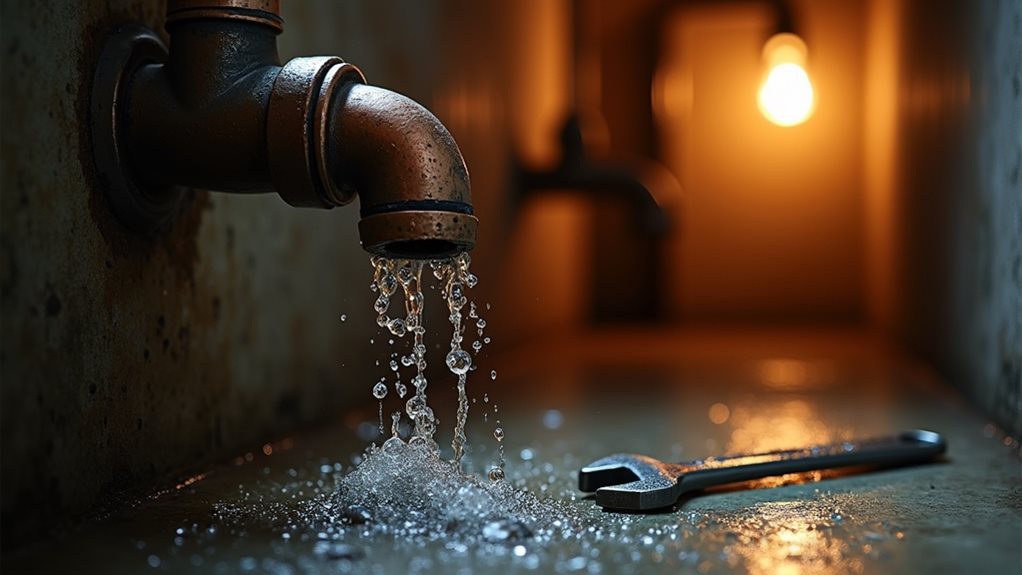
Water hammer happens when moving water in a pipe suddenly stops or changes direction, and that abrupt deceleration converts the fluid’s momentum into a pressure surge that races along the piping as a shockwave.
You’ll detect loud banging and possible pipe vibration as the pressure wave transmits, and you should know this shock can damage fittings, stress supports, and create spikes described by fluid kinematics and inertance theory. A related hazard in steam and condensate systems is the sudden collapse of steam pockets, known as steam hammer, which can produce very large, damaging pressure spikes. Understanding the principles of fluid kinematics can help in mitigating these issues effectively.
Common Causes That Trigger Water Hammer
You’ll commonly see water hammer triggered by fast-closing valves, like those in washing machines and some appliance solenoids, which stop flow abruptly and send strong shockwaves through the piping. Additionally, a lack of proper lubrication for hinges in appliances can contribute to increased noise and vibration, which may exacerbate the sensation of water hammer in plumbing systems.
Another frequent cause is waterlogged air chambers or blocked shock absorbers, which lose their ability to cushion pressure spikes, allowing those waves to travel unattenuated and make pipes bang. Understanding these two mechanisms—sudden valve shutoff and failed cushioning—helps you target inspections and fixes, such as installing dampers or servicing air chambers, to reduce recurring hammer. Sudden changes in flow velocity create pressure surges because flowing water has momentum and a rapid stop sends a shock through the system flowing water momentum.
Fast-Closing Valves
Consider how quickly a valve shuts: when a valve closes rapidly, the moving fluid’s kinetic energy is forced to stop almost instantly, producing a sharp pressure surge that travels through the piping and can exceed design limits.
You should know that swing checks, solenoids, and similar fast-closing valves create large hydraulic shocks; slower or spring-assisted designs, and calculated closure timing, reduce spike magnitude and damage risk.
Waterlogged Air Chambers
Fast-closing valves are a common cause of sudden pressure surges, but another frequent and often overlooked trigger is an air chamber that’s lost its air cushion.
You’ll hear banging when chambers fill with water and stop compressing, since hydraulic shock then slams pipes.
Draining chambers, removing scale, or installing arrestors restores cushioning, prevents leaks or bursts, and stops recurring water hammer.
How Air Chambers and Air Relief Work
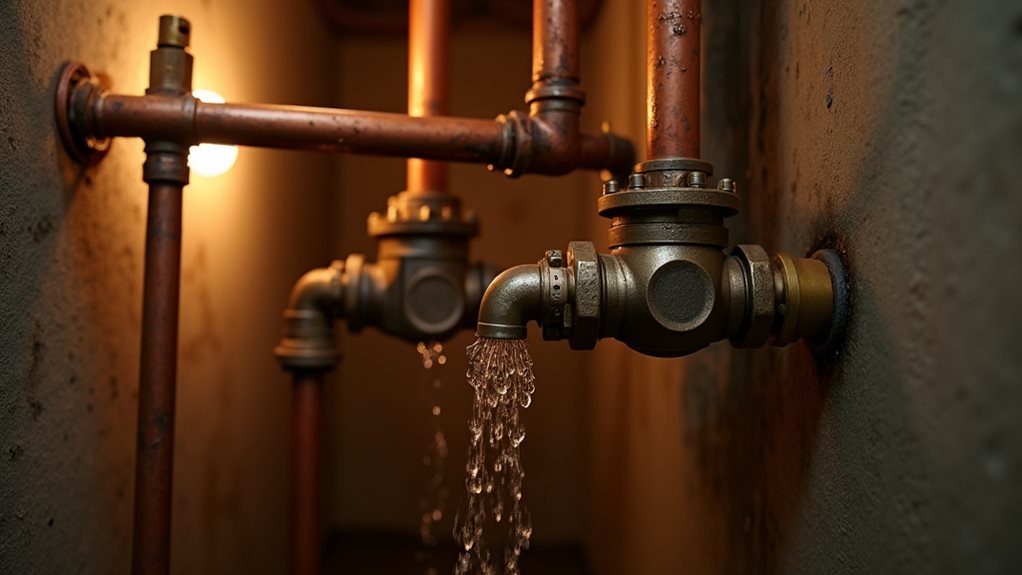
Air chambers and air-relief mechanisms work together to cushion sudden pressure surges by keeping a compressible pocket of air available where water flow is abruptly stopped, so the shock energy gets absorbed rather than transferring into the pipe walls. You’ll find chambers near fast-closing valves; relief valves admit air to prevent waterlogging, preserving cushioning, reducing noise, and protecting pipes from damage. Proper curing of pipe joints is also crucial to ensure that they can withstand the pressure fluctuations caused by water hammering.
The Role of Water Pressure in Hydraulic Shock
When water moving through a pipe is abruptly stopped or redirected, the system’s pressure level plays a central role in how severe the resulting hydraulic shock will be, because higher baseline pressure and faster flow mean more kinetic energy is available to convert into a pressure spike.
Higher operating pressure amplifies surge magnitude, increases noise and risk of damage, and makes rapid valve closures far more hazardous.
How Pipe Condition and Support Affect Hammering
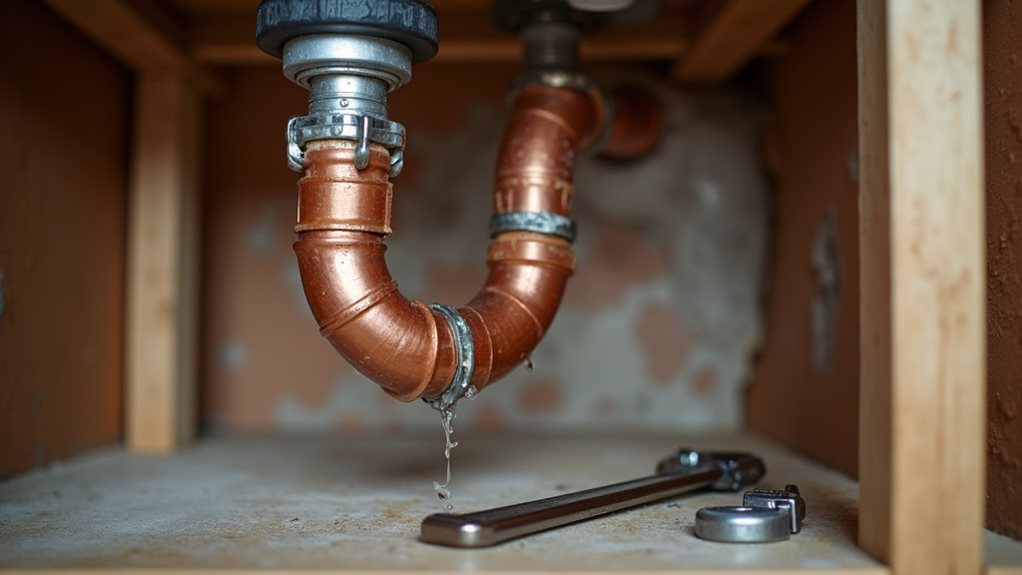
Although you might focus on valves and pressure regulators, the physical state of the piping and its supports largely determines how a system responds to a surge, because material properties, deposits and mountings control how pressure waves are absorbed, transmitted or amplified.
You should prefer flexible, less rigid pipe materials, remove scale and sediment, and secure supports or add cushioning to reduce transmitted shocks.
Signs Your Plumbing Is Experiencing Water Hammer
Frequently, the first sign you’ll notice of water hammer is a sharp, loud bang or series of knocks coming from your walls or near fixtures, and those sounds are caused by the sudden stop of moving water creating pressure shockwaves in the pipes.
You may also feel pipe vibrations, see damp stains or small leaks near joints, notice reduced pressure, or observe repeated, patterned knocking indicating worsening shock events.
Short- and Long-Term Risks of Ignoring Water Hammer
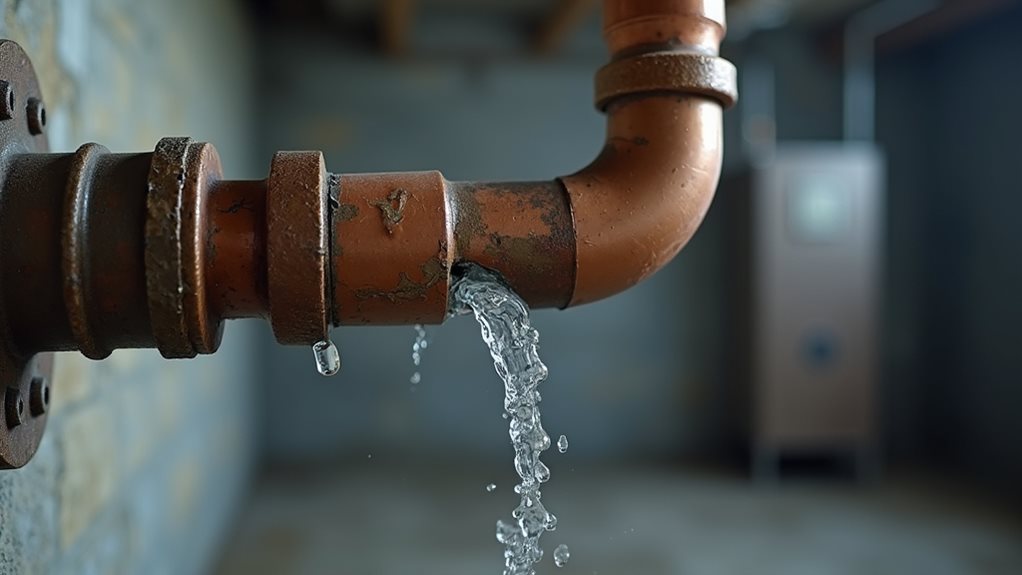
If you ignore water hammer, repeated hydraulic shocks will fatigue metal pipes and fittings, creating hairline cracks that can grow into persistent leaks or catastrophic bursts over time.
Those same pressure spikes and vibrations also stress appliance solenoid valves, washing machines, dishwashers, and fixtures, shortening component life and increasing the likelihood of costly failures.
Addressing the problem early — by securing piping, installing arrestors, or replacing worn valves — prevents progressive system degradation and protects both your appliances and your property.
Pipe Fatigue and Leaks
When water hammer keeps sending sudden pressure spikes through your plumbing, joints and pipe walls start to weaken from repeated shock loading, and what begins as tiny micro-fractures at fittings or along welded seams can grow into persistent leaks and, eventually, full fractures.
You’ll see cyclic fatigue in metal pipes, accelerated corrosion, loosened fittings and escalating leaks that raise repair costs and burst risks.
Appliance and Fixture Damage
Beyond the slow wear and leaks that pipe fatigue causes, water hammer poses immediate and cumulative risks to the fixtures and appliances attached to your plumbing system.
Repeated shock waves jar valves, seals, and fast‑closing appliance connections, loosening joints and causing leaks, cracks, sensor failures, and premature pump or heater damage. Ignoring it raises repair costs, flood risk, and potential safety hazards.
Immediate Actions to Reduce Hammering Noises
You can take several immediate steps to quiet water hammering and prevent further pipe damage, starting with safe, temporary measures that restore cushioning and limit sudden pressure changes; first, shut off the main water valve and open the highest and lowest faucets to drain and refill the system, which helps recreate air chambers that absorb shock, then slowly reopen the main valve to avoid a rapid surge.
Tighten loose straps, wrap exposed pipes with foam, partially close taps to slow stops, and check pressure levels, reducing force until permanent solutions are applied.
Professional Repairs and Hardware Solutions
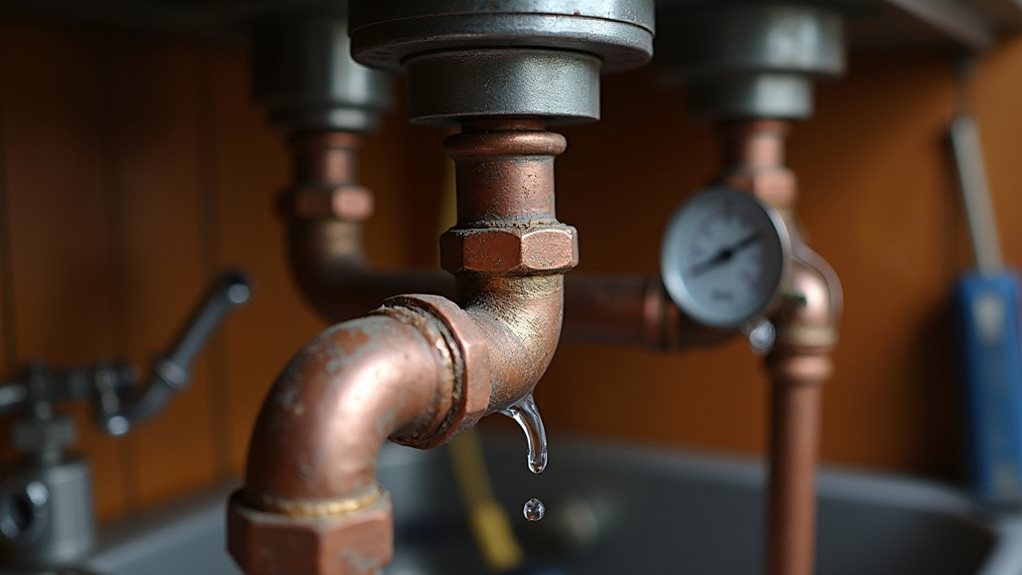
You can get lasting relief from water hammer by having a professional install water hammer arrestors near fast‑shutting valves or appliances, since these air‑filled devices absorb the shock waves that cause loud banging.
Equally important is securing and supporting pipes with properly spaced straps, clamps, and padded brackets to prevent movement that amplifies pressure surges. A qualified plumber will evaluate placement and pipe support needs together, combining arrestors and sturdy mounting to give a reliable, code‑compliant solution.
Water Hammer Arrestors
Frequently, plumbers and facility managers call on water hammer arrestors when sudden valve closures or appliance cycles create damaging hydraulic shocks, and these compact devices are engineered to absorb that energy, protect fittings and valves, and extend system life.
You’ll choose ASSE/ANSI-certified arrestors, sized per manufacturer guides, with piston or floating designs, sealed gas cushions, durable materials, and ratings to handle high working and burst pressures.
Pipe Supports and Clamps
Pipe supports and clamps are the unsung workhorses of any plumbing or mechanical system, and they’re essential for keeping pipes aligned, secure, and functioning over time.
You’ll choose between steel, rubber-lined, plastic, or heavy-duty clamps based on load and vibration needs, use riser clamps for vertical runs, and install correctly to control expansion, prevent sagging, reduce noise, and avoid costly alignment failures.
Preventive Maintenance to Keep Water Hammer Away
Because sudden valve closures and pressure spikes can damage fittings and disturb occupants, preventive maintenance focuses on controlling pressure, cushioning shocks, and keeping the system mechanically sound.
You should install and monitor pressure regulators, fit water hammer arrestors near fast-closing valves, replace quick-shut faucets with slow-closing models, secure and repair piping, and periodically drain or replace air chambers to maintain effective shock absorption.
Final Note
You’ve learned that water hammer is a hydraulic shock caused when moving water stops suddenly, and that high pressure, worn valves, or inadequate pipe support make it worse. You can reduce noises immediately by shutting off water gently, draining lines, or tapping pipes to seat air chambers, but lasting solutions include installing arrestors, pressure-reducing valves, or replacing failing components. Maintain systems with periodic inspections and pressure checks to prevent recurrence and protect piping long-term.
I use an air bladder